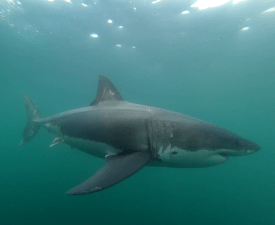Increasing presence of white sharks in Atlantic Canada

As part of my postdoctoral work at the Maurice Lamontagne Institute, Fisheries and Oceans Canada, I had the opportunity to contribute to the first systematic assessment of white shark (Carcharodon carcharias) presence in Atlantic Canadian waters. This project was carried out under the supervision of Dr. Xavier Bordeleau (Maurice Lamontagne Institute) and Dr. Heather Bowlby (Bedford Institute of Oceanography), and in close collaboration with several other Canadian and US partners.
Why this research matters
White sharks are an apex predator and play an important ecological role in marine ecosystems. In the Northwest Atlantic, the white shark population declined by more than 70% in the second half of the 20th century, mainly due to overfishing. While protective measures in the United States have led to signs of recovery, in Canada the species remains legally listed as endangered. Understanding their movements and presence in Canadian waters is crucial for conservation and for evaluating progress toward recovery goals.
How we studied white sharks
To address this question, we relied on a large-scale acoustic monitoring system deployed and maintained by the Ocean Tracking Network. From 2014 to 2023, acoustic receivers moored at two key locations—the Halifax line and the Cabot Strait line—continuously recorded acoustic detections of over 260 white sharks tagged in US waters through a long-term research program by the Massachusetts Division of Marine Fisheries and the Atlantic White Shark Conservancy. This consistent and decade-long monitoring allowed us, for the first time, to quantify trends in white shark presence in Atlantic Canada.
Key findings
Our analyses revealed a clear and rapid increase in white sharks visiting Canadian waters:
- More sharks migrating north: The probability that sharks tagged in the US migrated into Atlantic Canada more than doubled since 2018 at the Halifax line, and nearly quadrupled at the Cabot Strait.
- Longer stays: On average, sharks in 2023 spent about 70 days per season in Canadian waters, compared to less than 50 days in earlier years.
- Recent trend: This increase began around 2019–2021, marking a noticeable shift in the seasonal presence of white sharks off eastern Nova Scotia and in the Gulf of St. Lawrence.
Although early data were limited, the results consistently point to white sharks becoming more frequent visitors to Canadian waters in recent years.
What this means
The increasing presence of white sharks could reflect both population recovery and shifts in distribution, potentially driven by environmental changes and prey availability. For Canada, these findings are key: up to 30-40% of the Northwest Atlantic tagged population now uses our waters seasonally. Monitoring year-to-year changes is essential to ensure conservation actions remain effective, not only for white sharks but also for the broader marine ecosystems where they play a critical role.
Acknowledgments
This work was made possible thanks to the support and collaboration of many individuals and institutions. I am deeply grateful to my supervisors, Dr. Xavier Bordeleau and Dr. Heather Bowlby, and to my co-authors Megan Winton, Gregory Skomal, Warren Joyce, Vianey Leos Barajas, and Marc Trudel. The Ocean Tracking Network provided essential infrastructure for this work, and many colleagues in Canada and the US contributed to the tagging, monitoring, and data collection efforts. I also thank the Fisheries and Oceans Canada Species at Risk programs, the Massachusetts Division of Marine Fisheries, and the Atlantic White Shark Conservancy for their financial and logistical support.